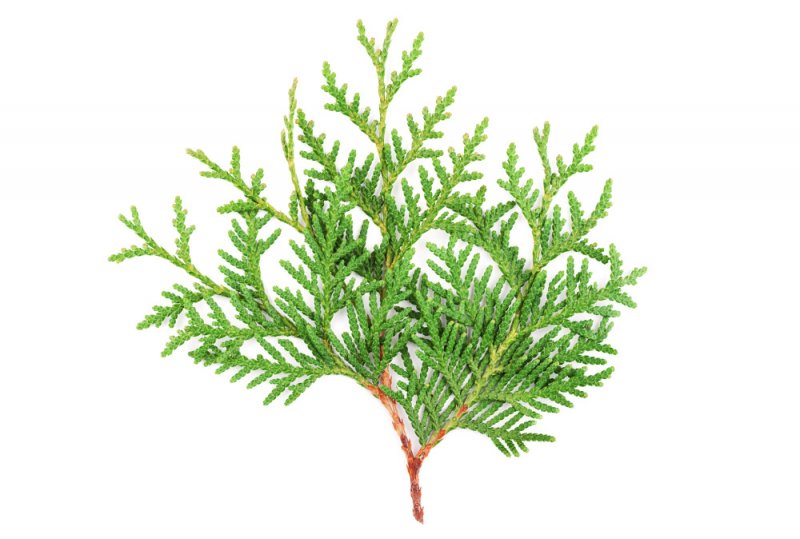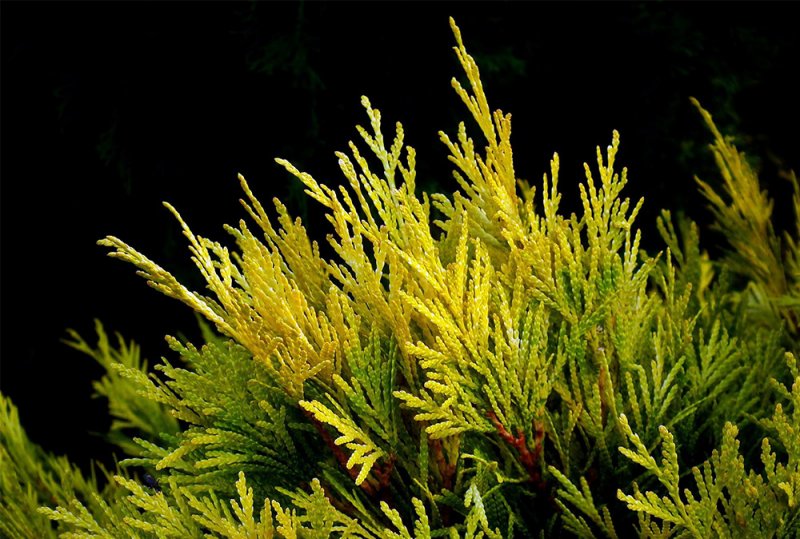

Thuja Occidentalis
Thuja occidentalis is an evergreen tree that has been used for centuries for a variety of medical conditions.
The indigenous peoples of North America not only appreciated the tree for its light and durable wood, but also for its medicinal properties.
They used its leaves and leaf oil to treat coughs, fever, headaches, menstrual disorders, as well as muscle and joint pain and other complaints. Externally, the essential oil was used for skin diseases and as an insect repellent.
It is reported that they also made a tea from the scaled leaves of Thuja occidentalis (Eastern White Cedar). This herbal tea was found to contain 50 mg of vitamin C per 100 grams and thus help to prevent and treat scurvy effectively.
European settlerslater adopted the use of Thuja in traditional medicines for its immune-boosting and antiviral activities.
Today, the essential oil of the tree is used against bacterial skin infections, warts or cold sores. Another of the many thuja benefits are its strong effects against bacteria and fungi.
In homeopathy, Thuja occidentalis is used as a remedy for acute bronchitis and other disorders of the upper airways. The plant can help with catarrh and loosen mucus.
Thuja Origin and types
Thuja occidentalisis an evergreen coniferous tree belonging to the cypress family (Cupressaceae).
There are five different types of thuja. Three of the species are native to the eastern regions of Asia. Thuja sutchuenensis is one of them and counts as an endangered species.
The two other species, Thuja plicata and T. occidentalis, are indigenous to Eastern Canada and North America.
Thuja plicata or Western Red Cedar is the most important species to produce timber. It is also sometimes called "Canoe Tree", referring to its use as a material for Native American canoes.
Probably the hardiest of the species is Thuja occidentalis. It is also known as Eastern White Cedar, Northern White Cedar, Hackmatack or Eastern Arborvitae.
Despite being called cedars, thujas belong to the false cedar trees. The true cedar trees belong to the pine family. Thuja occidentalis is not only used for its insect resistant, durable wood but also widely in Alternative Medicine.What does the plant look like?
Northern white-cedar trees can grow up to 20 meters (about 65 feet) tall.
Their trunks are sometimes forked near the ground and covered with a thin reddish-brown bark that peels in vertical strips. The tree’s crown is green all year. It has a conical shape and is dense.
Small, scalelike leaves grow on characteristically flattened branchlets. Young leaves are much longer and look needle-like. Small, green to brown coniferous cones contain the seeds.
Varieties of Thuja occidentalis are often grown as ornamentals and hedges. They can vary a lot in height and shape.
Some cultivated varieties have a fast growth rate and can put on three feet in height per year. Other dwarf varieties, such as Danica arborvitae, grow just to one to two feet tall.


The American arborvitae is another ornamental type of arborvitae. For its beautiful foliage, the semi-dwarf tree is also known as emerald green arborvitae. The globe arborvitae shrubs are named after their natural globe shape.
Where does the name come from?
The five species of the genus Thuja are commonly known as thujas, cedars or arborvitae.
The name “Arbor vitae” is the Latin term for “tree of life”. It is credited to the French explorer Jacques Cartier and refers to the medicinal properties of the plant.
“Thuya” is an Ancient Greek name for some related species of evergreen, resinous trees after which the arborvitae got named.
Thuja as a medicinal plant
In homeopathy and evidence-based herbal medicine, thuja is used for a wide range of health issues related to the common cold.
Research done in test tubes and animals showed that Thuja occidentalis stimulates the immune system and has antiviral activities. Therefore, acute and chronic infections of nose, mouth, and throat are one of thuja’s main uses.
There is no clinical data available on Thuja as a single herbal substance. However, it was used in combination with the coneflowers Echinacea purpurea and pallida and with wild indigo (Baptisia tinctoria). These plants also act on the immune system.
A herbal remedy with extracts of Echinacea, Baptisia and Thuja was used in patients with a viral respiratory tract infection, also known as common cold.
The study showed that complaints were eased much faster and the duration of the illness was shorter compared to placebo.
Scientists also reported that white-cedar extract and oil are effective against many bacteria. Thuja has also been successfully used to support antibiotics in severe bacterial infections. These included bronchitis, angina, pharyngitis, middle ear and sinus infection.
Medicinal Properties of Thuja
- Stimulating the immune response
- Effective against certain viruses, bacteria, and fungi
How or what it is used for
Thuja homeopathy uses include the following:
- Boosting the immune system
- Common cold
- Bronchitis
- Expectorant (helps to loosen mucus)
- Swelling/inflammation of the nasal cavity
- Swelling of the sinuses
- Swelling/inflammation of the tonsils
- Cold sores
Applied directly to the skin, people use thuja for joint and muscle pain as well as osteoarthritis. The Cedar leaf oil is used for skin infections and warts. It is also a popular insect repellent.
How does it work?
T. occidentalis extract contains compounds that stimulate the immune system. One of them is a substance called thujone. It can be found in the essential oil of a number of aromatic plants, including thuja and sage.
Thujone seems to play an important role in activating the immune response in the body. Test tube results showed that even homeopathic preparations containing Thuja occidentalis can modulate the immune system.
However, thujone is also neurotoxic. Animal studies showed that it inhibits the activation of GABA-A (gamma-aminobutyric) receptors in the brain. By inhibiting this major calming neurotransmitter receptor, nerve cells can fire more easily. Therefore, high doses can cause muscle spasms and convulsions.


What makes Thuja different?
While the herb itself is toxic, homeopathic doses of thuja that can be safely used for many different health complaints.
Cautions and drug interactions
The herb should only be used in small amounts due to its ingredient thujone. Large doses of thuja can cause side effects such as queasiness or vomiting, stomach ache, diarrhea, headache, and seizures. An overdose can even lead to death.
Thuja should be taken with caution as it has several herb-drug interactions. It also could increase the symptoms of certain existing medical conditions.
Its use should be avoided by patients with autoimmune diseases like multiple sclerosis, lupus, or rheumatoid arthritis. The herb can increase the activity of the immune system, and this could increase the symptoms of autoimmune disorders.
Also, taking thuja along with some medications that suppress the immune system might make these drugs less effective.
Taking medications that increase the chance of having a seizure along with thuja might increase the risk of having a seizure. People with a history of having seizures or who are taking medications that prevent seizures should also avoid taking thuja.
Moreover, it is always recommended to consult a health care practitioner prior to use, especially when being pregnant or breast-feeding.
Pascoe products that contain Thuja:
Disclaimer
Pascoe Canada does not offer health or medical advice as we are not a healthcare practitioner. Please speak with your healthcare practitioner before beginning any program related to nutrition, diet, exercise, fitness, medical, and/or wellness. All content published by Pascoe Canada is developed through collaborating with licensed medical professionals and contributors. This includes text, graphics, images, and other material on the website, newsletter, and products (“Content”). This content is for informational purposes only and does not constitute medical advice. The content does not substitute professional medical advice, diagnosis, or treatment. Please always do your own research on whether this is for you along with your healthcare practitioner advice. Always consult your healthcare practitioner prior to use specific herbs because you might have underlined conditions needs professional care. The content is general in nature and are subject to change. It is not intended to cover all possible uses, directions, precautions, warnings, drug interactions, allergic reactions, or adverse effects.


